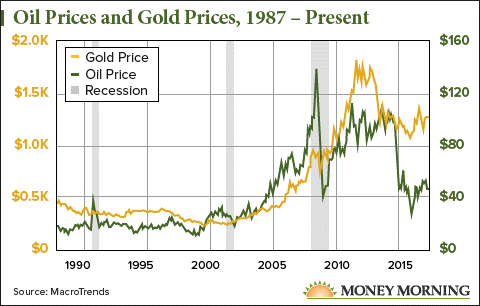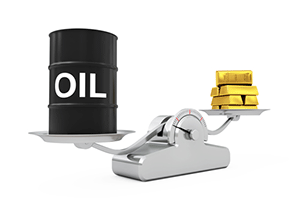Since both commodities are priced in U.S. dollars, there's a common myth among investors that the oil and gold prices relationship is defined by lockstep price movements.
When the U.S. dollar rises in value, most dollar-denominated commodities like oil and gold become more expensive. That means a gaining dollar can pull oil and gold prices lower because those commodities are more expensive to foreign currency users.
This is why market logic often asserts that oil prices and gold prices move in tandem with one another. If one goes down, the other also goes down - and vice versa.
However, as this chart below will show you, oil and gold don't always move in the same direction despite both being priced in dollars...
This Is When the Oil and Gold Prices Relationship Becomes Undone
You see, oil and gold prices typically untether during economic recessions...

The three recessions over the last 30 years were the early 1990s recession, the dot-com bubble of the early 2000s, and the 2007-2008 financial crisis. During these periods of economic decline, oil prices sharply declined while gold prices either remained steady or climbed in value.
Trending: How to Buy Physical Gold in 2017 - Free Report
For example, the most recent financial crisis lasted from the Dow Jones' peak on Oct. 12, 2007, to its bottom on March 6, 2009. Over that period, the WTI crude oil price cratered 45.6% from $83.69 to $45.52. On the other hand, the gold price soared 25.9% from $748.70 to $942.70.
The differing movement between oil and gold prices during these economic downturns comes from gold's nature as a safe-haven investment. Safe havens typically maintain or increase in value when the stock market nosedives. That's because investors buy them to hedge against losses they may incur from the stocks in their portfolio.
On the other hand, oil prices can plunge when the economy crashes. One big reason for this is recessions always reduce consumer spending, which causes less gasoline consumption since less people can afford to travel. As a result, oil demand falls since oil is used in the refining process to produce gasoline. That ultimately causes low oil prices.
While the oil and gold prices relationship changes during harsh economic times, two of our Money Morning experts expect both to move in the same direction this year - higher. In fact, both recently released their bullish gold and oil price predictions for 2017.
Here's how high you can expect these two commodities to climb this year...
Our Predictions for Oil and Gold Prices in 2017
 According to Money Morning Global Energy Strategist Dr. Kent Moors, WTI crude oil prices could reach the $54-$55 range by the end of Q2. Hitting the low end of the range would be an 18.5% gain from the current price of $45.56. Beyond that, he expects them to rise to $56-$58 by September 2017.
According to Money Morning Global Energy Strategist Dr. Kent Moors, WTI crude oil prices could reach the $54-$55 range by the end of Q2. Hitting the low end of the range would be an 18.5% gain from the current price of $45.56. Beyond that, he expects them to rise to $56-$58 by September 2017.
[mmpazkzone name="in-story" network="9794" site="307044" id="137008" type="4"]
Moors believes the effects of the OPEC production cut last year will eventually boost prices. Last November, the cartel agreed to cut output by 1.2 million barrels per day, bringing total daily output to 32.5 million barrels. It marked OPEC's first output cut since 2008 and pushed crude oil prices up 6% over the following two months.
Although prices have dropped 10.7% over the last month, OPEC and non-OPEC players like Russia are rumored to be extending their output cuts. Once that announcement is made, investor confidence will see a big boost and push prices to Moors' high targets.
Our gold price prediction for 2017 is also bullish. Money Morning Resource Specialist Peter Krauth - a 20-year veteran of the gold and silver markets - sees the metal rallying 14.2% from its current price of $1,226 to $1,400 by the end of the year.
A big reason Krauth sees gold heading higher on the global scale is soaring Turkish imports. He told Money Morning readers on April 7 that Turkey's gold imports in March grew 17-fold to 28.2 metric tons. The country's total Q1 imports leaped a stunning 1,479% to over 56 metric tons from the first quarter of 2016.
Turkish gold imports soared in March as citizens prepared for the outcome of a vote in which President Erdogan would receive broader executive powers. Erdogan won the vote by a narrow margin, which fundamentally changes the Turkish government from a parliamentary system to executive presidency.
This abrupt and drastic change in the country's government is precisely why citizens bought gold. And the fallout from the vote will continue to make citizens uncertain and more attracted to gold.
"Needless to say, Turks are uneasy about possible changes coming to their nation," Krauth said, "and they've turned to gold for protection in a big way."
The Bottom Line: The notion that oil prices and gold prices always move in the same direction isn't always true. During times of economic and stock market turmoil, the gold price often steadies or moves higher while the oil price plunges. Gold rallies because investors pile into it as a way to protect their money from stock market losses. Despite their price divergences during recessions, our experts expect both commodities to post big gains this year. The price of oil could rise as much as 27.3% to $58 by September, while the price of gold could gain 14.2% to $1,400 by the end of 2017.
Rare Gold Anomaly: The first time it created $1.25 billion in new wealth virtually overnight. The second time, it created a cash windfall of $6 billion - both times making in-the-know investors flat-out millionaires. And it's about to happen again, only this time we expect the cash windfall to reach $13 billion. If you take advantage of this rare gold anomaly right now, you, too, could walk away a millionaire. Details here...
Follow me on Twitter: @AlexMcGuire92


